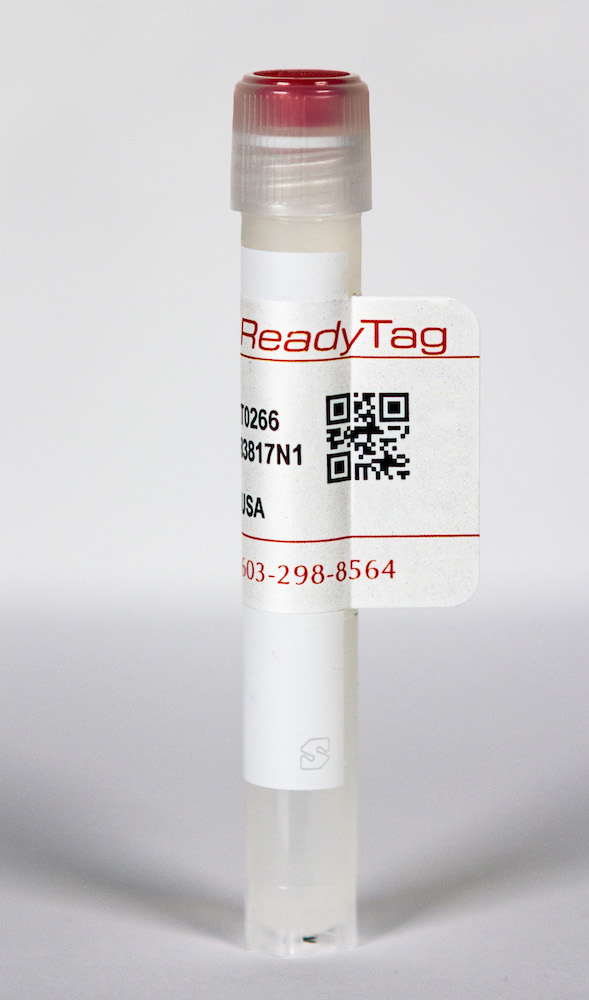ReadyTag anti-6-His
| Clone | 6-His | ||||||||
|---|---|---|---|---|---|---|---|---|---|
| Catalog # | RT0266 | ||||||||
| Category | ReadyTag Antibodies | ||||||||
| Price |
|
The 6-His monoclonal antibody reacts with polyhistidine (6-His). Histidine tags are commonly added to proteins of interest using recombinant DNA technology. The histidine tag can then be used for detection or purification of the tagged protein.
| Isotype | Mouse IgG1 |
| Recommended Dilution Buffer | InVivoPure™ pH 7.0 Dilution Buffer |
| Immunogen | Recombinant protein containing the sequence HHHHHH |
| Reported Applications |
|
| Formulation |
|
| Endotoxin |
|
| Purity |
|
| Sterility | 0.2 μM filtered |
| Production | Purified from tissue culture supernatant in an animal free facility |
| Purification | Protein G |
| RRID | AB_2687790 |
| Molecular Weight | 150 kDa |
| Storage | The antibody solution should be stored at the stock concentration at 4°C. Do not freeze. |
READYTAG ANTI-6-HIS (CLONE: 6-HIS)
Deinert, K., et al. (2001). “Arc1p organizes the yeast aminoacyl-tRNA synthetase complex and stabilizes its interaction with the cognate tRNAs.” J Biol Chem 276(8): 6000-6008. PubMed
Eukaryotic aminoacyl-tRNA synthetases, in contrast to their prokaryotic counterparts, are often part of high molecular weight complexes. In yeast, two enzymes, the methionyl- and glutamyl-tRNA synthetases associate in vivo with the tRNA-binding protein Arc1p. To study the assembly and function of this complex, we have reconstituted it in vitro from individually purified recombinant proteins. Our results show that Arc1p can readily bind to either or both of the two enzymes, mediating the formation of the respective binary or ternary complexes. Under competition conditions, Arc1p alone exhibits broad specificity and interacts with a defined set of tRNA species. Nevertheless, the in vitro reconstituted Arc1p-containing enzyme complexes can bind only to their cognate tRNAs and tighter than the corresponding monomeric enzymes. These results demonstrate that the organization of aminoacyl-tRNA synthetases with general tRNA-binding proteins into multimeric complexes can stimulate their catalytic efficiency and, therefore, offer a significant advantage to the eukaryotic cell.
Kojima, H., et al. (2001). “rDrak1, a novel kinase related to apoptosis, is strongly expressed in active osteoclasts and induces apoptosis.” J Biol Chem 276(22): 19238-19243. PubMed
This is the first report of a novel serine/threonine kinase, rabbit death-associated protein (DAP) kinase-related apoptosis-inducing protein kinase 1 (rDRAK1), involved in osteoclast apoptosis. We searched for osteoclast-specific genes from a cDNA library of highly enriched rabbit osteoclasts cultured on ivory. One of the cloned genes has a high homology with human DRAK1 (hDRAK1), which belongs to the DAP kinase subfamily of serine/threonine kinases. By screening a rabbit osteoclast cDNA library and 5′-RACE (rapid amplification of cDNA ends), we obtained a full length of this cDNA, termed rDRAK1. The sequencing data indicated that rDRAK1 has 88.0, 44.6, 38.7, and 42.3% identity with hDRAK1, DAP kinase, DRP-1, and ZIP (zipper-interacting protein) kinase, respectively. To clarify the role of DRAK1 in osteoclasts, we examined the effect of three osteoclast survival factors (interleukin-1, macrophage colony-stimulating factor, and osteoclast differentiation-inducing factor) on rDRAK1 mRNA expression and the effect of rDRAK1 overexpression on osteoclast apoptosis. The results suggested that these three survival factors were proved to inhibit rDRAK1 expression in rabbit osteoclasts. After transfection of a rDRAK1 expression vector into cultured osteoclasts, overexpressed rDRAK1 was localized exclusively to the nuclei and induced apoptosis. Hence, rDRAK1 may play an important role in the core apoptosis program in osteoclast.






